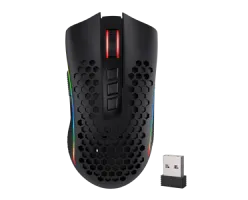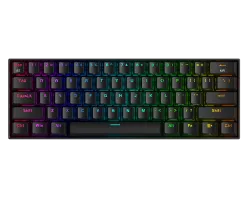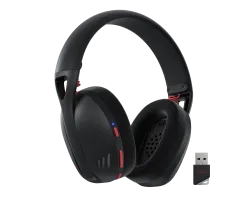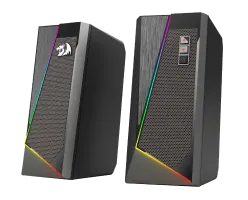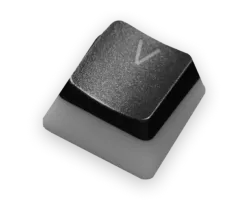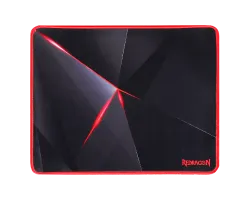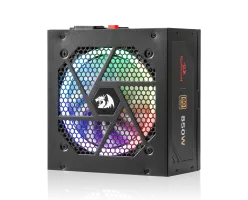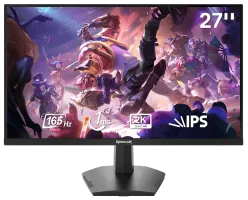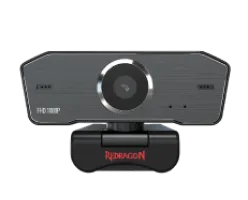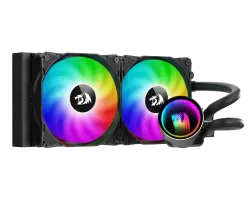KEY FEATURES: 1) HOT-SWAP, 2) BROWN OPTICAL SWITCH, 3) MACROS, 4) MEDIA CONTROLS, 5) Custom RGB UI Improved!
STANDARD REDRAGON KEYBOARD FEATURES:
• ABS double-shot keycaps, N-Key Rollover, Standard Bottom Row, MX Stems
• 18 RGB lighting modes, animated & steady 7 rainbow colors + White + OFF
• Software (optional) available for more granular/detailed control of Lighting/MACRO/Profiles.
• Almost all user setting can be achieved via key combinations directly from the keyboard.
• User settings are remembored by the keyboard, can be unplugged and plugged back in later.
STANDOUT FEATURES
• HOT-SWAPPABLE Switches = End user-customizable / serviceable switches; longevity even when switches break or wear out
• OPTICAL Switches = Rated 100 million keystrokes durability, TWICE compared to regular switches (hot-swappable if fail).
• Outemu OPTICAL Switches are lighter than Outemu REGULAR 3-pin Switches (see below for subjective relative comparison of switches).
• BROWN Switches = Tactile speed-bump feel on down-stroke, no additional audible 'TICK' that may be noisy for some.
• Improved RGB back-lighting interface using FN+[~], FN+[SPACE] = easily pick available colors for PER-KEY RGB customization.
• Dedicated Media Keys and Scroll Bar = control Windows volume with Scroll Bar, buttons for Prior-Track / Play-Pause / Next-Track
• MACRO buttons that support recording from the keyboard. More precise Macro settings, possible with additional software.
• Slim, elegant thin design. Aluminum top frame with chamfered sides - allows THIN ~1cm base, ~2cm thick for the ridge above main keys.
DESIGN CHOICES (As intended, but could be improved)
• Buttons (NOT regular KEYS) are used for MACROS and Media controls. They appear to be laser etched, not double-shot ABS.
• MACRO Buttons do not actuate crisply like the main key switches, there may be some variable delay in execution of MACROS. [Software might be helpful here.]
• MACRO/MEDIA Buttons are not RGB; RED LED only, like status lights. May color clash with non-red RGB themes.
• Flip-out feet and rubber pads could be bigger and more substantial; they are thin, likely corresponding to overall slim thin design.
• NON-BRAIDED attached cable - braiding may only be for top tier keyboards from Redragon; otherwise is still nice matte soft flexible covering.
QUALITY / COSMETIC ISSUES (does not affect function)
• 2mm and 3mm dings on the right aluminum chamfer, disrupts otherwise beautiful metallic accents.
• MACRO buttons are likely laser etched. Many of the lettering G1-G2-G3-G4-G5-REC are individually misaligned.
OVERALL: Upper mid-tier keyboard at a reasonable price. Enjoyable light Optical Brown Switches. Functional and elegantly slim with nice extra features.
ALTERNATIVES with similar feature set (all hot-swappable)
• K580-PRO (OPTICAL BLUE) = Same exact keyboard, but with Outemu OPTICAL BLUE switches
• K580 (REGULAR BLUE) = Same as above, but with Outemu REGULAR BLUE switches
• K586-PRO (OPTICAL BLUE) = flagship keyboard, Outemu OPTICAL BLUE switches, 5 additional "G" MACRO full-size KEYS, "M" buttons store/recall custom RGB Profiles
• K587-PRO (OPTICAL BLUE) = top-tier Ten-Key-less (TKL) version of K586-PRO, with LEFT side Macro Keys, detachable cable; no "M" RGB Preset Keys
• K592-PRO (OPTICAL BLUE) = upper mid-range keyboard, modest styling, RGB Sidebars; no dedicated MACRO/MEDIA Keys.
• K556 (REGULAR BROWN) = Elegant minimalist mid-range keyboard with chamfered aluminum frame; no dedicated MACRO/MEDIA keys
Below is a more in-depth discussion of some of the points made above.

✩ STANDARD KEYBOARD LAYOUT
The K580-PRO sports a Standard Bottom Row, so this is not an issue to worry about. Many expensive name brand keyboards have NON-Standard Bottom Row layouts that are not completely compatible with standard keycap sets. Specially-sized keycaps may be needed, or you may be limited to only sets from that particular brand.
Although the 104-key layout is generic, it is the STANDARD layout. This means the vast majority of replacement or custom key cap sets are compatible. There are many expensive name brand keyboards that do not have a standard bottom row. A Standard Bottom Row means the bottom row of the keyboard main keys [CTRL-SYS-ALT-SPACE-ALT-FN-MENU-CTRL] are of a particular defined size. Some layouts change this to add specialized arrow keys in a smaller physical keyboard. Some designs enlarge certain modifiers and made some keys smaller.
If you are interested in being able to easily replace or use custom key caps then the layout is worth considering when comparison shopping for a keyboard.
✩ HOT-SWAPPABLE Switches
The switches are not soldered to the PCB, and the end user can swap out switches to customize the feel of the keyboard or to repair/replace a malfunctioning switch. This is a great feature that can extend the longevity of a keyboard.
Hot-swappable switches are such a common feature nowadays that it should be considered standard for new keyboards. It's the first thing I look for when shopping for a new keyboard. Popular name brands have just started to introduce this feature - although they still cost many times more, and often use a non-standard bottom row.
Regular 3-pin switches are typically rated for 50 million clicks. Optical switches are rated for 100 millions clicks, because they are less dependent on mechanical aspects to function properly. However, because optical switches on keyboards are fairly new development, it is unclear what the typical lifespan is for the IR emitters/sensors. The new switches may last 100 million clicks, but it is wait-and-see if the IR beams/sensors will last just as long.
✩ BROWN vs BLUE Switches (Brief discussion of switch types)
There are generally TWO kinds of mechanical switches: 1) Linear (RED/BLACK), and 2) Tactile (BLUE/BROWN).
Linear switches offer smooth travel when a key is pressed until bottom out, there is no feedback of any kind. RED is lighter and BLACK is heavier. Tactile switches offer resistance when a key is pressed, much like going over a speed bump. Both BLUE and BROWN switches give this tactile feedback. In contrast to BROWNS, BLUE switches have an extra mechanism inside the switch that creates a 'TICK' to generate additional audible feedback.
Which switch to choose is largely a personal preference. A few factors are worth considering. One important aspect is feel, linear versus a tactile switch. If you are skillful with a keyboard and can quickly grasp the actuation point of a key switch, then the linear switches might be suitable. For the general typist, the tactile feedback is probably most appropriate as it gives a nice feel as well as signals when a key actuates. Whether you want or need an additional
audible cue is a personal choice.
BLUE switches are the most common and most popular switches found in mechanical keyboards. People like them for the tactile feedback, and the crisp 'TICK' sound they make. After using BLUE switches exclusively for a few weeks, I've grown to enjoy them. Switching back to BROWN switches, the keys felt slightly mushy and less distinct.
The downside of BLUE Switches is that the extra ticking sound can be quite annoying for other people around you. The clicking is also easily picked up by microphones and would be a distraction in conversations or voice chats. It's not hard to find people that describe BLUE switches as too loud for their liking after trying them.
BROWN switches are a good happy medium. They provide tactile feedback of switch actuation and are as silent as REDS or BLACKS if you take care to not bottom out or top out. So even though I've found BLUE switches quite enjoyable, I find BROWN switches preferable for most situations.
* A note about NOISE from a mechanical keyboard. The loudest and most prominent sound from a keyboard for me is actually the topping out sound - when a key is released and pops up to its resting position. This is difficult to control consistently - probably just the way I type. Likewise, a heavy key press will also generate a loud thwack against the base plate when a key bottoms out - common with DELETE/TAB/ENTER, etc. Bottoming out can be partially remedied with o-rings installed to the stems of the key caps (not switches). They act as silicone bumpers to dampen the vibration and reduce noise and finger fatigue. They are very inexpensive (<$1 for 120 on eBay). Fifteen minutes of fiddling 120 o-rings to fit the key cap stems might be worth considering.
✩ Outemu OPTICAL vs REGULAR Switches4>
A Simple Relative Switch Force Test - Outemu Regular vs Outemu Optical
Pushing uninstalled switches opposed against each other by the MX Stems allowed a comparison of the switch force required when pressing a key switch. The actuation point is generally around 1.5 to 2mm, so the first switch to get past half-way mark is deemed the lighter switch. After testing different switch combo pairings, a RELATIVE scale of the heaviness can be laid out.
* Spare Outemu switches as provided with hot-swap keyboards were used for testing.
* Sixteen switches total, 2 each of Optical BLUE/RED/BROWN/BLACK, and Regular BLUE/RED/BROWN/BLACK 3-pin, were used.
* Note that there is some variability even among switches of the same type. Only 2 of each kind was used for testing.
* (O = Optical, R = Regular 3-pin Outemu). Lightest on left, Heaviest on right.
O-RED < R-RED < (O-BROWN ≈ O-BLUE) < (R-BROWN < R-BLUE) < O-BLACK < R-BLACK
In general, the Optical Switches are lighter than their Regular counterparts. Note that Optical BLUEs are at about the same force as Optical BROWNs, whereas the Regular BLUES are slightly heavier than Regular BROWNS. Also, note that Optical BLUES are slightly lighter than Regular BROWNS.
* In terms of actual typing, the difference between Optical BROWNS and Regular BROWNS is very small. The difference is only more perceptible between Optical BLUES vs Regular BLUES. If much typing is required, lighter switches may help reduce finger fatigue. The above scale can be helpful for those preferring a particular weight in their switch preference.
✩ RGB IMPLEMENTATION (Surprise new UI FN+[SPACE] is GENIUS!)
Redragon keyboards have steadily improved on the RGB lighting features over the years. Recent RGB keyboards all supported the Redragon standard 18 modes of animated RGB light show. FN+[~] was added a few years ago to allow for individual PER-KEY customization without using the software. However, it was tedious to cycle through the available
8 preset colors (Rainbow7 + White + OFF) to set each key. The new FN+[SPACE] combo enters the "Color Picker" mode, where the available palette of colors is displayed across the keyboard and you only need to press the color desired to pick it as the color to use. This not only works in PER-KEY FN+[~] mode, but also in one of the 18 RGB modes that
support different colors. Some of the 18 modes do not offer color variations then FN+[SPACE] does nothing, some modes only offer 4 color variations, then only F1-F4 are lit with the available colors. Previously only the limited pallet of 7 rainbows + 1 white colors could be accessed via FN+[→], now with FN+[SPACE] the palette expands to over 100
for modes that support it. I was very impressed with how well this worked. I hope this becomes a standard feature for all future Redragon RGB keyboards.
Sadly FN+[SPACE] does not work on K586-PRO (even with the most recent firmware available), nor does it work on the K556. Hopefully, it won't be too difficult to add this new UI feature to the firmware for older RGB keyboards.
✩ DEDICATED MEDIA BUTTONS
There are dedicated media controls on the upper right. Three buttons control Play/Pause and Prior-Track/Next-Track functions. A fourth button toggles the volume or light mode for the Scroll Bar. The Scroll Bar controls the overall Windows sound volume. I misunderstood the K586 manual and thought the Volume/Brightness toggle switches the Scroll Bar to control the Windows screen brightness. The manual for K580 is clearer. The Scroll Bar actually controls the brightness of the RGB on the keyboard itself. So the SCROLL BAR replicates FN+[F2]/FN+[F3] for volume control, and alternately via the toggle, FN+[↑]/FN+[↓] for the keyboard's RGB brightness level.
✩ MACRO BUTTONS
MACRO recording on-the-fly is pretty straight forward. It's easy to use and can be pretty handy for repetitive tasks.There are two issues with the button implementation, however, one functional and one cosmetic.
MACROS default to F1-F5. Custom MACROS are simple to record. REC-G1<start>-[Desired Macros]-REC<end>, the corresponding customized G1 key will light up, along with REC. I encountered some latency with getting the Macros to activate when the buttons are pressed in quick succession, so there can be a variable delay between MACROS. I'm not sure if it is because there are time delays that are required by default, or I waited too long to end my recording. If more precise timing is required, the available software might be helpful as it allows more control of the MACROS.
There are no extra keys placed to the left of a standard keyboard layout for MACROS. This may be a good feature for some users, but I've found that I often mistakenly press a key there instead of CTRL or instead of ESC on the K586-PRO. Perhaps more time than a few weeks is required for me to get use to the new extra keys. On the K580 there are only G1-G2-G3-G4-G5-REC buttons above the F-keys, no extra keys to press by mistake. Since I can become confused by the extra keys, in my use case, I can do without the dedicated MACRO keys to the left.
✩ ALTERNATIVE KEYBOARDS with similar key features, some suggestions
1) If BLUE Switches are preferred, the K580-PRO also comes in an OPTICAL BLUE Switch version. The standard non-PRO K580 comes with regular BLUE Switches. For a step up, the K586-PRO is also an OPTICAL BLUE Switch keyboard. It features more dedicated MACRO Keys, and new 'M' buttons for storing custom RGB profiles.
2) K556 can be considered for a mid-tier REGULAR BROWN Switch. The K580-PRO is the only OPTICAL BROWN Switch keyboard from Redragon at this time (Oct 2019). If OPTICAL switches are too new and unknown to consider, the K556 is a good consideration.
It has a full aluminum outer shell and sides with a chamfer all the way around the edge. It is an excellent choice if dedicated to MACRO/MEDIA keys are not needed.
✩ OVERALL
Considering features, functionality, aesthetics, and most importantly value, the K580-PRO (OPTICAL BROWNS) is a great keyboard. Whether a product is a good value depends entirely on what it offers for the price. The K580-PRO has the basics in a solid package and adds some very nice extras in functionality with MACROS and MEDIA KEYS. The slim aluminum design and excellent RGB functionality and UI are quite pleasing. The pricing puts it at Redragon's upper mid-tier in their keyboard range. At two-thirds the MSRP of name brand ENTRY-level keyboards that don't offer hot-swappable switches or standard bottom rows for easy
key cap customization, this is a very worthwhile keyboard to consider.
Hope that was helpful. Thanks for reading.
Author: Robhi




